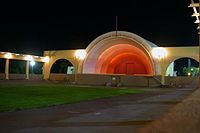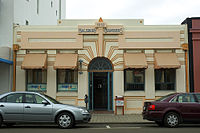| Revision as of 13:27, 11 May 2007 editBotMultichill (talk | contribs)Bots310,824 editsm robot Modifying: no:Napier (New Zealand)← Previous edit | Revision as of 08:17, 19 May 2007 edit undoHayden5650 (talk | contribs)786 edits rm unofficial name from position of titleNext edit → | ||
| Line 1: | Line 1: | ||
| {| class="infobox bordered" align=right cellpadding=4 cellspacing=0 width=275 style="clear:right; margin: 0 0 1em 1em; background: #f9f9f9; font-size: 95%;" | {| class="infobox bordered" align=right cellpadding=4 cellspacing=0 width=275 style="clear:right; margin: 0 0 1em 1em; background: #f9f9f9; font-size: 95%;" | ||
| |- | |- | ||
| |colspan=2 align=center bgcolor="#BFDFFF"|<big>'''Napier'''</big><br |
|colspan=2 align=center bgcolor="#BFDFFF"|<big>'''Napier'''</big><br> | ||
| |- | |- | ||
| |]: || ] | |]: || ] | ||
Revision as of 08:17, 19 May 2007
| Napier | |
| Country: | New Zealand |
|
| |
| Population: | 56,700 (urban) 55,800 (territorial) |
| Urban Area | |
|---|---|
| Extent: | the city, Eskdale, Waiohiki Awatoto |
| Territorial Authority | |
| Name: | Napier City |
| Mayor: | Barbara Arnott |
| Extent: | Bay View to Taradale & Awatoto |
| Land Area: | 106km² |
| Website: | http://www.napier.govt.nz |
| See also: | Hastings City |
| Regional Council | |
| Name: | Hawke's Bay |
| Website: | http://www.hbrc.govt.nz |
Napier (Ahuriri in Māori) is an important port city in Hawke's Bay, New Zealand. It has a population of 57,000. Ten kilometres to the south lies Hastings, Napier's twin city. The two are sometimes known in New Zealand as "The Twin Cities".
The town is 332 kilometres (about four hours) northeast by road from the capital, Wellington. It has a population smaller than Hastings, but as Hastings is administered as a district, Napier is the only city in the Hawke's Bay region, which is the largest crossbred wool centre in the Southern Hemisphere and one of the largest apple, pear and stone fruit producing areas in New Zealand. It has also become an important grape growing and wine production area with the fruit passing from the growers around Metropolitan Hastings and then to Napier for exporting. There are large frozen meat, wool, pulp and timber tonnages passing through Napier’s port.
Napier is a popular retirement town and tourist resort, and has one of the most photographed tourist attractions in the country, a statue on Marine Parade called Pania Of The Reef. Her statue is regarded in Napier in much the same way that the Little Mermaid statue is regarded in Copenhagen, and bears some similarities to its Scandinavian equivalent. In October 2005 the statue was stolen, but it was recovered a week later, largely unharmed.
History
Napier has well-documented Māori history. When the Ngāti Kahungunu party of Taraia reached the district many centuries ago, the Whatumamoa, Rangitane and the Ngāti Awa and elements of the Ngāti Tara iwi existed in the nearby areas of Petane, Te Whanganui-a-Orotu and Waiohiki. Later, the Ngāti Kahungunu became the dominant force from Poverty Bay to Wellington. They were one of the first Māori tribes to come in contact with European settlers. Te Whanganui-a-Orotu is regarded as a Taonga Tuku Iho (a treasure for all time).

Chief Te Ahuriri cut a channel into the lagoon space at Ahuriri because the Westshore entrance had became blocked, threatening cultivations surrounding the Whanga and the fishing villages on the islands in the lagoon. The rivers were continually feeding freshwater into the area.
The first European to see the future site of Napier was Captain James Cook, who sailed down the east coast in October 1769. He commented: "On each side of this bluff head is a low, narrow sand or stone beach, between these beaches and the mainland is a pretty large lake of salt water I suppose." He said the harbour entrance was at the Westshore end of the shingle beach. The site was subsequently visited and later settled by European traders, whalers and missionaries. By the 1850s farmers and hotel-keepers arrived.

The Crown purchased the Ahuriri block (including the site of Napier) in 1851. In 1854 Alfred Domett, a future Premier, was appointed Commissioner of Crown Lands and resident magistrate at Ahuriri. A plan was prepared and the town named after Sir Charles Napier, hero of the Battle of Meeanee in the Indian province of Sindh. Domett named many streets in the settlement to commemorate the great colonial era of the British Indian Empire. He also displayed his own literary preferences by naming streets after famous artists and literary figures.
The town was constituted a borough in 1874 and development of the surrounding marsh lands and reclamation proceeded slowly. Between 1852 and 1876 Napier was the administrative centre for the Hawke's Bay Province, but in 1876 the Abolition of Provinces Act dissolved provincial government.


Development was generally confined to the hill and to the port area of Ahuriri. In the early days Napier consisted of an oblong mass of hills (Scinde Island) almost entirely surrounded by water, from which ran out two single spits, one to the north and one to the south. There was a swamp between the now Hastings Street and Wellesley Road and the water extended to Clive Square.
On 3 February 1931 Napier was levelled by an earthquake and ensuing fires, which killed 258 people. The town centre was destroyed and rebuilt in the popular Art Deco style of the time. Some 40 km² of today's Napier was undersea before the earthquake raised it. Although a few Art Deco buildings were replaced with contemporary structures during the 1960s, 1970s and 1980s (including, ironically, the Art Gallery), most of the centre remained intact for long enough to become recognized as architecturally unique, and from the 1990s onwards had been protected and restored. Napier and South Beach (Miami) are considered by many Art Deco enthusiasts the two best preserved Art Deco towns, Miami Beach being mainly in the later Streamline Moderne Art Deco style.
In January 1945, the German submarine U-862 entered the Port of Napier undetected. That event later became the basis of a widely circulated post-war myth that Kapitänleutnant Heinrich Timm took his crew ashore near Napier to milk cows to supplement their rations.
Geography and climate
The town is on the Bluff Hill headland and the surrounding plain at the southeastern edge of Hawke Bay, a large semi-circular bay that dominates the east coast of New Zealand's North Island. The coastline of the town was substantially altered by a large earthquake in 1931. Several smaller towns lie close to the city, some of which (such as Taradale) are now little more than large suburbs. Other surrounding towns include Bay View, to the north, Clive, to the south, Flaxmere, west of Hastings, and Havelock North.
The town enjoys some of the highest sunshine hours in New Zealand, its warm, relatively dry climate the result of its location on the east coast, a mediterranean climate delivered from the waters to the north, and its strategic position in Hawke's Bay. Most of New Zealand's weather patterns cross the country from the west, and the town lies in the rain shadow of the North Island Volcanic Plateau and surrounding ranges such as the Kaweka Range. However, the town is prone to the remnants of tropical cyclones from the central Pacific Ocean, which occasionally are still at storm strength by the time that they have reached Hawke's Bay. Thunderstorms are not very common in Hawke's Bay with less than 10 thunderstorms a year. They are most common in the summer caused by the sometimes extreme surface heating. Hail from thunderstorms can damage vineyards and orchards. The hailstorm of 2 March, 1994 created hailstones up to 3cm in size and caused around NZ$10.8m worth of damage to orchards and vineyards. It remains New Zealands most costly hailstorm.
Tourism
Napier's major tourist attraction is the town itself, which draws Art Deco and architecture enthusiasts from around the world. The rebuilding period after the 1931 earthquake coincided with the shortlived and rapidly changing Art Deco era and the Great Depression, when little 'mainstreet' development was being undertaken elsewhere. As a result Napier's architecture is strikingly different from any other city; the other notable Art Deco city, Miami Beach, has Streamline Moderne Art Deco. The whole centre of Napier was rebuilt simultaneously. In many ways it resembles a film set as it has whole streets of 'in period' buildings, but it is a real city and the buildings are original. Santa Barbara, California was rebuilt after an earthquake in 1925 and is notable for its Spanish Mission Style buildings.
Other tourist attractions in Napier include Marineland, the National Aquarium and the Soundshell. Attractions nearby include the Cape Kidnappers Gannet Colony and many vineyards bordering Hastings City. Many people use Napier as a gateway to Hawkes Bay, flying in to the Hawkes Bay airport at Westshore from Wellington City, Auckland and Christchurch. From Napier, tourists explore Hastings City, Havelock North, Wairoa and Cape Kidnappers.
Tourists flock to Napier in February for Art Deco weekend and the Mission Concert Weekend. The large wine industry hosts the Annual Harvest Hawkes Bay Weekend.
Many tourists enter Napier by State Highway 2, by rail (though this is becoming uncommon) or by air. Hawkes Bay is served by Hawkes Bay Airport which is located north of the marina.
Industries
The range of industries in Napier and its environs include the electronics industry, the surrounding area wool trade, and the manufacture of fertilizer and wine. Napier is home to one of New Zealand's largest smoking tobacco plants. On 9 September 2005 British American Tobacco announced it would close the iconic Rothmans factory, due to diminished demand. Production will be moved to Australia. The famous art deco-style factory has been producing up to 2.2 billion cigarettes a year for the New Zealand and Pacific Island markets. In March 1999, 19 people lost their jobs there because "fewer people are smoking".

Notables
- Kevin Rigby — field hockey player
- Darren Smith — field hockey player
- Spencer Gollan
- Debbie Harwood (When The Cat's Away)
- Teresa Cormack - young murder victim
- Kel Tremain - All Black
- Mike Boon - Teacher and former comedian
Notes
- Provisional figures from the 2006 New Zealand Census, at stats.govt.nz
External links
| Local government in New Zealand | |
|---|---|
| Territorial authorities | |
| Regional councils | |
| Other councils | |
| Related organisations | |
| Authorities in italics are unitary authorities | |
| New Zealand articles | |||||||||
|---|---|---|---|---|---|---|---|---|---|
| History | |||||||||
| Geography |
| ||||||||
| Politics |
| ||||||||
| Economy | |||||||||
| Society |
| ||||||||
39°29′S 176°55′E / 39.483°S 176.917°E / -39.483; 176.917
Categories: